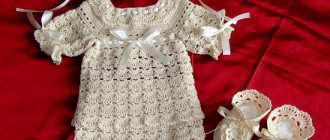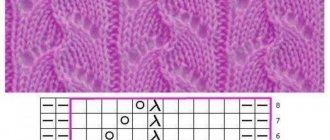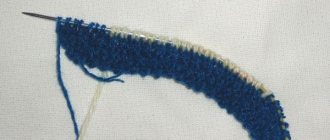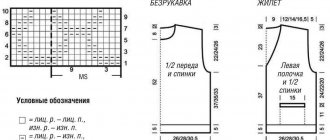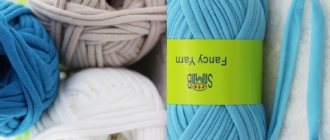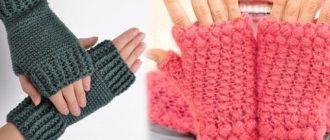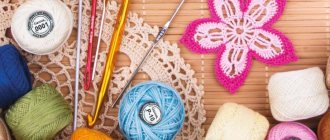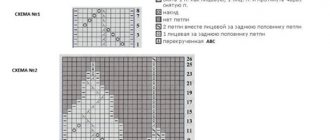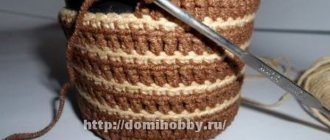Standard sizes of a blanket for newborns
Before you start knitting a product, you need to decide not only on the quality and quantity of yarn used, or the color and pattern of the blanket, but also on its size.
An incorrectly selected blanket size can cause the following problems:
- A baby knitted blanket that is too large will be heavy and will easily slide off the bed;
- a very small blanket will not be able to fully cover a child or wrap a newborn in a stroller;
- If you plan to put a duvet cover on the blanket, you need to keep in mind that it is only sold in standard sizes.
A blanket for a newborn should be knitted in a standard size, taking into account where it is planned to be used.
For example:
- for a crib measuring 60x120 cm, a blanket 120 cm long and 80 cm wide is suitable;
- To prevent the child from opening up, you can knit a slightly larger blanket, for example, 110x140 cm, and fold the corners under the mattress;
- for walks in the cold, it is best to knit a blanket 100x140 cm or a little larger;
- in summer you can use a square blanket 90x90 cm.
What size of blanket the newborn will have needs to be decided based on one’s own desires and preferences.
Yarn selection
The quality and density of the threads primarily depend on the time of year in which the baby is due to appear. For babies born in spring or summer, choose lighter yarn, for those born in winter or autumn, choose warm and dense yarn. When purchasing, you should take a closer look at their labeling. It is advisable that the label indicate that the yarn is intended for children's clothes.
Yarn selection table for the baby's birth season:
| Winter | Summer |
| Wool. The threads are made of 100% natural wool, dense and soft. However, the individual characteristics of the child should be taken into account, since pure wool is not suitable for sensitive skin. | Cotton. The yarn is 100% mercerized cotton. The quality of the threads will increase the density and reduce the tendency of the product to damage significantly. You can also find cotton yarn without mercerization. These threads are very soft and thicker. However, it is worth paying attention to the fact that products made from them require careful handling. |
| Wool + bamboo + acrylic. Good for kids prone to allergies. At the same time, the product will be quite soft and warm. | Cotton + polyacrylic. For those who find cotton too stiff, you can choose a blended thread. The blanket will be soft and pleasant to the touch. |
| Wool + acrylic + alpaca wool. A blanket made from such threads will be very light and warm at the same time. | Acrylic. Pure acrylic threads are dense and pleasant to the touch. For children's clothes, you should definitely choose acrylic yarn marked “baby”. |
You should know that:
- The cotton thread should be dense, without thickening or tears . A product made from such yarn requires more threads due to the fact that they are thinner than acrylic or wool. A blanket made of very thin threads will wear out quickly.
- You should not buy woolen threads with long lint, which can get into the baby’s mouth or nose. You also need to carefully check the quality of the yarn. Real wool fibers should not break when stretched. It is better to try the yarn in advance by touching it to your cheek or other part of the body and, if unpleasant sensations appear, refuse to purchase.
- Low quality acrylic threads will creak when knitting ; they are not intended for babies. Products made from acrylic may stretch if washed frequently.
How to calculate the amount of yarn for knitting, depending on the number of knitting needles, thickness and type of thread
It is not difficult to knit a blanket for a newborn. Before starting work, you need to decide on the type of yarn, as well as its quantity depending on the thickness of the knitting needles. Knitting needles are usually #3 or #6. Each skein has a different length and weight of yarn.
Therefore, it is recommended to perform the following steps before starting knitting:
- It is necessary to check how the product will behave after washing. To do this you need to knit a small square of about 10x10 cm.
- Then the square is washed and dried.
- After this, you need to count how many loops and rows there are in the sample. Based on the calculations, a pattern will be constructed.
- Next, the sample is unraveled and the length of the threads used is measured.
- The area of the future blanket is calculated based on the size of the washed sample. You need to understand how many of these squares will be needed for the entire product.
- As a result, you need to multiply the resulting number of squares by the length of the thread used in 1 sample. The result is a figure that shows how many meters of yarn will be needed.
You also need to know that:
- Thicker yarn will have less consumption;
- the weaker the twist of the thread, the more economically the yarn is consumed;
- patterned knitting requires more threads;
- a product knitted with openwork knitting will require less thread;
- when knitting with an elastic band, more yarn is used;
- The thicker the knitting needles, the more economically the yarn is used (but it is worth remembering that such knitting needles are not suitable for all threads).
Very often, the thread label does not indicate its length, but its weight. The exact weight of yarn required for knitting a baby blanket can be calculated from an already knitted and washed sample. In this case, the sample is weighed and the resulting mass is multiplied by the number of squares. The result is a number equal to the weight of yarn for the blanket.
Tool selection
All knitting needles vary in size and shape:
- Single straight models.
- Circular knitting needles, with fishing line.
Depending on the shape of the chosen blanket model, you should focus on the choice of knitting needles. The diameter of the knitting needle is also an indicator that depends on the thickness of the thread, the knitting method and the specifics of the pattern.
Patterns for children's blankets. Knitting patterns and descriptions
A blanket for a newborn can be knitted using a variety of techniques. You can consider several of the most common patterns for blankets. It will be more convenient if you use the diagram during the work process.
The table shows several options for knitting patterns for a baby blanket:
| Option | Job |
| "Rubber" | Loops are cast on, the number of which should be divided into 5 + 3 symmetry loops and 2 edge loops. The cycle consists of 8 rows, each of which begins and ends with an edge loop. In each odd row, 3 knit stitches, 2 purl stitches, 3 knit stitches are knitted. In the 2nd and 6th it is the other way around, starting with the purls. 4th and 8th - knitted. A product with such a pattern will be elastic and is perfect for a children's blanket, as it does not have a reverse side. |
| Embossed "Wave" | The loops must be a multiple of 11 + 2 edge loops. The rapport consists of 14 rows. You need to start and end the row with an edge loop. Knitting order:
|
| "Scythe" | To start working, you need to cast on enough loops so that their number is divisible by 21. Then, in rows:
The cycle of 6 rows is repeated again until the required length of the product. |
You can choose a pattern for a baby blanket from a knitting magazine or find it on the Internet. If the needlewoman has extensive knitting experience, you can come up with your own pattern or motif.
Step-by-step instructions for knitting a plain blanket for a newborn
A blanket for a newborn is always knitted in the same sequence of steps. First, the required number of loops is cast on the knitting needle, then the main fabric of the product is knitted, and finally the loops are closed and the decor is selected.
Before starting work, you need to decide on the desired size and pattern of the blanket, the type of yarn and the thickness of the knitting needles. It is better to knit a simple plain blanket for a baby with simple knitted yarn and not add decorative details. For beginners, it is better to start knitting with simple patterns. You can try making a blanket 80x80 cm with a square pattern. To do this you will need 350 g of knitted threads.
Set of loops
Any knitting must begin with a set of loops.
It's not difficult to do this:
- You need to take a skein of yarn and unwind a little thread.
- The unwound thread is taken by hand (for a right-handed person in the left, for a left-handed person in the right) and thrown over the index finger with the free end first.
- The same end is wrapped around the thumb from left to right, so as to form a figure eight with another thread.
- Both threads are clamped with free fingers.
- Two knitting needles are taken in the right hand.
- The knitting needles are inserted into the loop on the thumb from bottom to top, forming a loop.
- You need to pull the thread from your index finger into this loop, bringing the knitting needles from top to bottom.
- Next, the loop is removed from the thumb and tightened on the knitting needles.
- Then you need to put the thread back on your thumb and repeat the whole procedure.
Thus, 175 loops are cast on the knitting needles, after which 1 knitting needle is pulled out.
Knitting fabric
Before knitting the main pattern, you need to decorate the edge of the blanket. To do this, the first few rows should be knitted in simple garter stitch. Usually the first loops, which are called edge loops, are removed, but here they need not be removed, but knitted with facial loops.
The first 11 rows are knitted with simple knit stitches:
- The knitting needle with loops remains in the left hand, and the empty one in the right.
- The thread from the skein is thrown over the index finger and clamped with the remaining fingers.
- The free knitting needle is inserted into the starting loop from left to right. In this case, the tip of the knitting needle, passed through the loop, grabs the thread from the skein from the bottom to the top and pulls it back.
- A loop is formed on the free knitting needle. The old loop is removed from the knitting needle with the stitches cast on.
- The procedure will be repeated the required number of times, in this case - 175.
- The row ends with a purl loop. The thread is placed in front of the knitting needle, which is wound from right to left and grabs the free edge from top to bottom.
- In order for the product to be proportional, you need to make 10 increases in the 11th row using the double crochet method. To do this, after knitting 11 loops from the edge, you need to throw the thread over a working knitting needle and continue knitting with facial loops. Yarn over is repeated after every 18 stitches in the row.
- In the last row of the main fabric, you need to remove 10 added loops. You need to remove them in the same order as you threw them on. First after 11, and then after every 18, the knitting needle passes through two loops at once;
- The work ends with 11 rows of loops using the garter technique.
The main pattern is knitted taking into account that the first and last 7 stitches of the row will be knitted using the garter technique. The cycle consists of 24 rows and is repeated 11 times.
Knitting pattern for the main fabric:
| Row No. | Scheme |
| 1, 3, 9, 11, 14, 16, 22, 24 | 9 knit (the yarn over between the loops in the 1st row is knitted with a crossed knit), 9 purl, and so alternates 9 times. At the end of the row, 9 knit stitches are knitted. Then the product is turned over and the next row is knitted. |
| 2, 4, 10, 12,12, 15, 21, 23 | The knitting pattern differs only in that first 9 purls are knitted, then 9 knits and so on until the end. The row ends with 9 purl loops. |
| 5, 7, 17, 19 | Knit 3, purl 3, and so on until the end of the row, which should end with 3 knit stitches. |
| 6, 8, 18,21 | 3 purl, 3 knit, everything is repeated until the end, the last 3 purl loops are knitted. |
Closing the loops
To prevent the product from unraveling, the last row of loops must be closed.
To close the loops you need:
- Knit the first edge stitch.
- Knit the next stitch.
- Using a knitting needle with loops, you need to pick up the first loop and pull the second through it with a working knitting needle.
- Knit the knit stitch again and pull it into the previous one.
- Repeat across the entire row.
- When finished, seal the ends of the thread.
Decorating a blanket
After the blanket is knitted, it must be washed, laid out on a horizontal surface and given the desired shape. After drying, the edges of the product can be decorated with ribbons, tulle or lace. To make the decor look neat, it is sewn on with monofilament, a strong thread that resembles fishing line.
Schemes for newborns
A knitted product will serve more than one generation and will be preserved as a family treasure. The blanket will not only be a beautiful blanket, but will also warm the child in cold weather and protect from drafts.
Method for beginners
This model is suitable for use at any age. The blanket is pleasant to the touch, soft and light. And knitting it with knitting needles will not be difficult because of the basic method of execution: a simple double-sided pattern of knit and purl stitches, as well as garter stitch for the sides of the product.
Knitting patterns for a blanket for a newborn are presented in the description. The product can be knitted as a decoration for discharge or presented as a gift to the baby.
Knitting explanation:
- L, I - front and back loop.
- R - row.
- P - loop.
When calculating the number of loops, the parameters of the product and repeat are taken into account. The usual size of a baby diaper is 80*80 cm, so they focus on it. It is important that the pattern is symmetrical, so loops are added to the repeats. The main knitting is 74 cm, one pattern repeat is 18 P (8 cm).
The double-sided element of the “cage” pattern consists of alternating L and I with a three-dimensional texture. The rapport is 18 p wide, 24 p long.
Execution in rows:
- 1, 3, 9, 11 - 9 L, 9 I.
- 5, 7 – 3 L, 3 I.
- 13, 15, 21, 23 – 9 I, 9 L.
- 17, 19 – 3 I, 3 L.
The pattern is repeated from 1 to 24 r.
Cast on the knitting needles 175 p and knit 11 p in garter stitch. The edge is decorated by knitting the front loop behind the back one. At 11 r, yarn overs are made to add loops. At the end of the work, the loops are closed.
A simple garter stitch
To keep the blanket warm, it is knitted from wool or wool blend threads.
Delicate care and attitude are important for a child. Therefore, pay attention to the indication of children's and cleaned threads. The composition should contain an admixture of acrylic, merino wool, “Baby alpaca” with the addition of microfiber. The thread should not be prickly or hard. A detailed description and patterns of a knitted blanket for a newborn are presented in the master class. Standard fabric reaches 1-1.5 m in size. You will need 500 g of yarn, knitting needles with fishing line and a hook. Cast on 195 P and knit a garter stitch pattern. To do this, the first row will be L. In each row, the first loop is not knitted, but removed onto another knitting needle. Starting from the second row, knit L. Subsequent rows are similar.
How to knit a colored blanket. Step-by-step instruction
A blanket for a newborn knitted from yarn of different colors will be very bright and festive. The products are knitted with knitting needles No. 5.5 in knit and purl stitches. To work you will need yarn of different colors (4 skeins of 170 g each). The blanket consists of 3 multi-colored stripes. The stripes are knitted in a pattern with holes and separated by pearl stitch of a different color.
It is better to knit a colored blanket for a newborn using pearl stitch
Step-by-step description of the work:
- A total of 129 loops are cast on. The edge loop is always removable.
- The edge of the blanket is knitted with a pearl pattern, alternating 1: front and back loops in 6 rows. Multi-colored stripes are also separated by the same pattern.
- Starting from the 7th row and until the end of the work, 5 loops are first knitted along the edges: 1 edge, 1 knit, 1 purl, 1 knit, 1 purl; At the end of the row, 5 loops are knitted in the reverse order.
- From the 8th to the 12th, from the 14th to the 18th rows, only knit rows are knitted.
- 13th row: 8 knit, 1 yarn over, 2 loops in 1 knit crossed, the row ends with 8 knit and 5 edge loops.
- 19th row – first knit 4, then repeat: 1 yarn over, 2 loops in 1 knit crossed, knit 6. At the end there will be 4 knit stitches and 5 edge stitches.
- From the 8th to the 19th row, repeat 2 times.
- The next 6 rows are knitted.
- Then another color is taken and the dividing strip is knitted.
- Next, all actions are repeated starting from the 7th row, only in a different color.
- The last 6 rows of the product are knitted with a pearl pattern.
- At the end of the work, you must close the last row in any way.
Blankets knitted with relief patterns from knit and purl loops
Here you can come up with options from the simplest blankets, knitted with regular garter stitch or checkerboard stitch, to more complex patterns. Schemes of some patterns can be found in this blog: for blanket 1 in the photo - description here (note that this pattern is also double-sided), for blanket 2 - see the diagram here, and I also want to draw your attention to simple blanket 3. It is crocheted with a garter knitted diagonally with a wide separating edge. A detailed description of how this is done can be found in this article. These options may work well for beginners.
By combining only knit and purl stitches, you can knit not only patterns, but also various pictures on children's themes. Here you will find bear cubs, and bunnies, and hearts, and stars, and so on. Many such ready-made patterns can be found on the Internet, or you can even take simple cross-stitch patterns and translate them into the “language” of knitting, replacing contrasting colors with knit/purl stitches.
And if you wish, you can make a 2 in 1 blanket, with a toy, “introducing” some other animal into it, so that the child will be warm and amused at the same time:
Knitted openwork children's blanket
This blanket will be very beautiful and perfect for the baby's discharge. Usually the product is made in a square shape from yarn in white or pastel colors. A product measuring 86x70 cm will require 450 g of knitted yarn.
Description of work:
- 1st, 3rd, 11th and 13th rows: all front rows;
- 5th: 1 knit, 1 yarn over, 1 pull through (slip 1 loop through which to pull 1 knit), 1 knit, knit 2 loops together, 1 yarn over, 4 knit. Knit the entire row in this way;
- 7th: 2 knit, 1 yarn over, 1 double yarn over (slip 1 loop through which to pull 2 knit stitches), 1 yarn over, 5 knit stitches. Repeat until the end;
- 9th row: knit 3, bump, knit 6. Repeat the steps until the end;
- 15th row: knit 6, 1 yarn over, 1 pull through, knit 1, knit 2 stitches together, 1 yarn over, knit 6. Repeat;
- Row 17: knit 7, 1 yarn over, 1 double yarn over, 1 yarn over, knit 7. So until the end of the row;
- 19th row: knit 8, bump, knit 8. The action is repeated until the end of the row;
- all even rows are knitted with purl stitches;
- the entire cycle is repeated until the desired length of the product;
- The strip should be knitted separately and sewn to the main fabric using a knitted seam.
A blanket knitted on its own will warm a newborn baby or decorate his discharge from the hospital. Products for babies are knitted with knitting needles of different thicknesses, different types of yarn and using numerous techniques.
Article design: Vladimir the Great
Children's plaid openwork patterns
The openwork pattern on newborns looks very gentle. It is not at all difficult to knit with your own hands and even a novice knitter can handle it.
You will need:
- 350 gr. acrylic yarn;
- knitting needles No. 3.5.
Knitting density: 25 p.x40 p. (10x10 cm).
Description
The blanket is knitted with hexagon motifs. The diagram is shown in the figure. The height of each is approximately 20 centimeters. Plat.elm. - all face loops. Triangles - diagram 2.
It will require knitting twenty-two hexagons. For knitting one hexagon. cast on eight loops:
1 rub. – 1 cr.p., *1 l.p., 1 nak.* 6 times, 1 cr.p. Next we knit according to the pattern. Repeat the rapport indicated in the diagram 6 times. We knit up to row 36 and loosely close the loops. It is also necessary to knit six half-hexagons, repeating the rapport only three times.
Now let's start knitting triangles. To do this, you need to sew the edges of all hexagons. Then we connect the first and second hexagons. There are poles on the sides. we raise twenty loops at a time - 40 in total. We knit a row of i.p. and then according to scheme No. 2 from the first to the 17th p.m. In the 18th row we knit three loops together sp, two loops together sp, throw on the first stitch. to the second. It turned out to be one loop. We knit according to the same pattern, knitting triangles, and connect the hexagon. and half-hex. We do this based on the drawing.
Assembly
From each edge we raise 200 stitches and knit five cm in garter stitch. In this case, you need to add one stitch on each side 10 times in every second row. We close the loops. Sew the edges. We moisten the finished product and wait for it to dry. The children's openwork blanket is ready!
